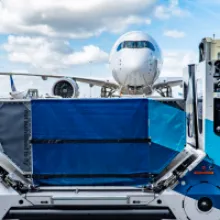SHERIDAN, WYOMING – Feb. 28, 2025 – Royal Schiphol Group, in collaboration with KLM, is spearheading a new era of baggage handling with the deployment of Aurrigo International’s innovative Auto-DollyTug. This self-driving baggage vehicle aims to optimize the separation of passenger baggage with long transfer times, addressing the challenges of high-volume baggage processing.
Addressing Peak Baggage Handling Challenges
On an average day, Amsterdam Airport Schiphol manages approximately 31,000 pieces of baggage from transferring passengers, with a significant surge in the morning. This influx places considerable strain on the airport's baggage system and handling operations. To mitigate these pressures, Schiphol is testing the all-electric, autonomous Auto-DollyTug. This vehicle is designed to efficiently transport luggage from passengers with extended layovers from the aircraft to a secure, temporary storage location.
Phased Implementation and Testing
The trial of the Auto-DollyTug began in August of the previous year, focusing initially on the route from the temporary baggage storage area to a secured storage location. The autonomous vehicle subsequently delivers the baggage to the baggage hall at the appropriate time, enabling seamless integration into the system for further processing and transfer to connecting flights.
During this initial phase, the vehicle utilized 3D cameras to map the platform environment and learn to navigate independently. The testing progressively included various aspects, such as autonomously picking up and dropping off containers and maneuvering through the bustling baggage hall.
Commitment to Sustainable and Automated Operations
“Schiphol is committed to creating a more sustainable, emission-free ground operation. We are replacing our entire vehicle fleet with a connected network of autonomous, emission-free vehicles,” commented Jan Zekveld, senior manager innovation at Royal Schiphol Group. “By doing so we automate all related processes. Even in an autonomous ground operation, employees will continue to play a crucial role, with their work becoming more varied and supervisory.”
Expanding Testing to Pier and Aircraft Stands
The current phase of testing involves the Auto-DollyTug operating on the pier, where it must navigate through denser traffic conditions. Successful performance in this phase will lead to the expansion of test routes, with plans to test the vehicle at aircraft stands by the end of 2025.
Advanced Navigation and Safety Features
The Auto-DollyTug is equipped with lidar sensors and 360° cameras, enabling it to navigate safely among other traffic, brake in a timely manner, and maintain sufficient distance. For safety assurance, an operator remains present in the vehicle during the trial to intervene when necessary.
Driving Innovation in Aviation
Professor David Keene, CEO of Aurrigo International, stated, “Working with forward-thinking partners like Schiphol and KLM to bring autonomous solutions to real-world aviation challenges is very exciting. The work we are doing demonstrates a fantastic use case for our self-driving Auto-DollyTug, showcasing how automation can enhance efficiency while supporting the workload for baggage handlers and easing pressure on airport systems. We’re proud to support Schiphol’s vision for a smarter, more sustainable future in ground operations.”
Future Implications for Air Travel
The successful implementation of the Auto-DollyTug at Schiphol Airport signifies a significant step towards more efficient, sustainable, and automated airport operations. This innovation not only enhances baggage handling efficiency but also contributes to a smoother travel experience for passengers by reducing delays and improving overall airport logistics. As airports worldwide face increasing demands, solutions like the Auto-DollyTug are poised to become integral to the future of air travel.
For more information visit.
